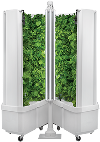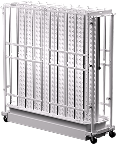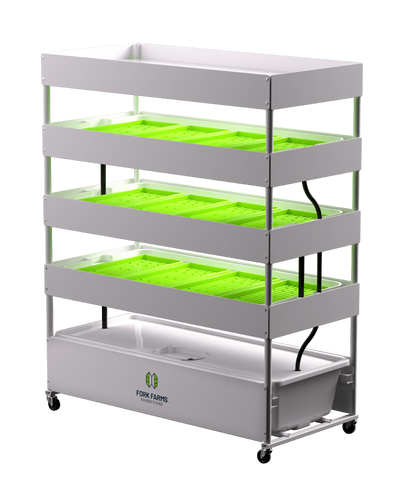What Types of Fruits and Vegetables Can You Grow With a Hydroponic Garden?
Hydroponic gardening allows you to grow fruits and vegetables without using soil. Instead, plants are grown in a special nutrient-rich solution, which can result in faster growth rates and higher yields compared to traditional soil-based gardening. The best part is that you have complete control over everything, from the temperature to the nutrients the plants receive.
Hydroponic gardens have numerous benefits, including faster plant growth, higher yields, and the ability to grow produce even when it's not in season. They also use less water and don't need a big plot of land, making them a great solution for urban gardening or those with limited outdoor space. What’s more, you don't ever have to worry about the weather interrupting your growing season..
Hydroponic gardening is a versatile option for growing a wide range of plants, as it can be done indoors. Plus, crops that are grown hydroponically are highly nutritious. For detailed information on the nutritional value of these foods, you can visit the U.S. Department of Agriculture’s FoodData Central.
What Food Can You Grow With A Hydroponic Farm System?
The most common crop grown in hydroponic gardens is lettuce. But there are many other options, too. Let's take a look at some of the different types of plants you can grow:
Leafy Greens - The Most Common Hydroponic Garden Crop
Leafy greens are vegetables with green leaves you can eat. Some leafy greens, like lettuce, can be eaten raw in salads, while others need to be cooked. These vegetables are extremely healthy–and can help complete a balanced diet–because they're packed with nutrients and fiber, but low in calories and fat. Examples of leafy greens that you can’ grow in your hydroponic garden include spinach, arugula, kale, collard greens, Swiss chard, bok choy, tatsoi, and mizuna. Leafy greens are some of the main vegetables grown in hydroponic gardens.
Growing Herbs in a Hydroponic Garden
Herbs are plants that are used for their flavor, scent, or medicinal properties, among other characteristics. They can be fresh or dried, and they're often used in cooking to enhance the flavor of various dishes. Common herbs you can grow in a hydroponic garden include basil, cilantro, chives, parsley, dill, rosemary, sage, thyme, and oregano.
Fruiting Vegetables Are An Option With A Hydroponic Farm
Fruiting vegetables are a bit different because they produce a fleshy, edible fruit that contains seeds. Even though they technically count as fruits because they develop from a flower and contain seeds, we usually think of them as vegetables when it comes to cooking. Fruiting vegetables that you can grow hydroponically include tomatoes, peppers, hot peppers, strawberries, beans, peas, and cucumbers.
Explore Interesting Lettuce Varieties With Your Indoor Hydroponic Garden
In addition to the more familiar types of lettuce, you can try growing some really interesting and unique varieties in your indoor hydroponic garden. Some examples include Volcana, Red Oakleaf, and Sulu. These lettuce varieties will add both color and flavor to your plate.
What Fruits and Vegetables Can't Be Grown in a Hydroponic Garden?
While you can grow several different plants in a hydroponic garden, a few could present challenges. Root vegetables like carrots and beets and larger curds like cauliflower may be difficult to grow in a small hydroponic system and are better suited to a more elaborate setup. At Fork Farms, we recommend saving these for your outdoor gardens.
Other Important Considerations When Choosing What To Grow In Your Hydroponic Garden
When choosing what to grow in your hydroponic garden, there are a handful of additional considerations to keep in mind. Different plants have different needs, so it's important to consider factors like pH levels, nutrient mixes, pollination requirements for fruiting vegetables, and temperature. Some plants, like spinach, prefer cooler environments, while others, like tomatoes and peppers, take longer to grow than, say, lettuce.
It’s also important to think about the yields you want. If your goal is to grow a significant amount of food for the most amount of people, within a small space, some crops have higher yields than others. Plants, like leafy greens, will produce significantly higher yields than others, such as fruiting vegetables.
Recommendations For Getting Started with Hydroponic Gardening
If you're new to hydroponic gardening, it's a good idea to start with plants that are known to do well in this type of system. Romaine lettuce, butterhead lettuce, and basil are great options for beginners. And here’s a quick tip: Pelleted seeds are the easiest to plant and have a higher chance of sprouting.
But don't be afraid to experiment with different types of vegetables and varieties. There are thousands of options out there just waiting to be discovered.
Remember, you have an abundance of resources at your disposal to help you on your hydroponic gardening journey. At Fork Farms, our Farmative community has guides and information on growing leafy greens, herbs, and fruiting plants. These include a comprehensive growing guide for leafy greens; an herb growing guide focused on seed bundles; an experiment guide for fruiting plants; and recommended plant varieties for your garden.
We also have an expert team–with extensive food service and culinary backgrounds–on hand that can provide support and recommendations for properly harvesting and storing your fresh produce. So, get ready to explore the possibilities of your hydroponic garden; you’ll soon be on your way to enjoying fresh leafy greens and vegetables all year long!























